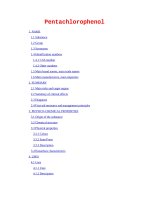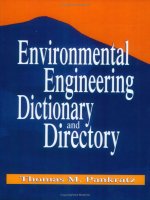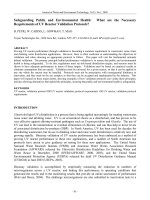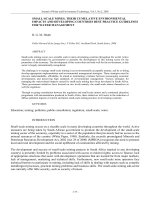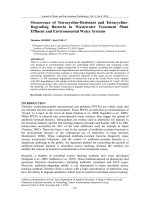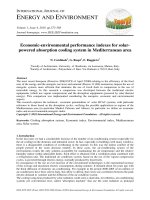Environmental chemometrics
Bạn đang xem bản rút gọn của tài liệu. Xem và tải ngay bản đầy đủ của tài liệu tại đây (2.9 MB, 316 trang )
www.pdfgrip.com
Environmental
Chemometrics
Principles and
Modern Applications
67966_C000.indd i
10/15/2008 8:17:56 PM
www.pdfgrip.com
67966_C000.indd ii
10/15/2008 8:17:57 PM
www.pdfgrip.com
A N A LY T I C A L C H E M I S T R Y
Environmental
Chemometrics
Principles and
Modern Applications
Grady Hanrahan
Ha nra ha n
67966_C000.indd iii
Boca Raton London New York
CRC Press is an imprint of the
Taylor & Francis Group, an informa business
10/15/2008 8:17:57 PM
www.pdfgrip.com
CRC Press
Taylor & Francis Group
6000 Broken Sound Parkway NW, Suite 300
Boca Raton, FL 33487-2742
© 2008 by Taylor & Francis Group, LLC
CRC Press is an imprint of Taylor & Francis Group, an Informa business
No claim to original U.S. Government works
Version Date: 20131121
International Standard Book Number-13: 978-1-4200-6797-2 (eBook - PDF)
This book contains information obtained from authentic and highly regarded sources. Reasonable efforts
have been made to publish reliable data and information, but the author and publisher cannot assume
responsibility for the validity of all materials or the consequences of their use. The authors and publishers
have attempted to trace the copyright holders of all material reproduced in this publication and apologize to
copyright holders if permission to publish in this form has not been obtained. If any copyright material has
not been acknowledged please write and let us know so we may rectify in any future reprint.
Except as permitted under U.S. Copyright Law, no part of this book may be reprinted, reproduced, transmitted, or utilized in any form by any electronic, mechanical, or other means, now known or hereafter invented,
including photocopying, microfilming, and recording, or in any information storage or retrieval system,
without written permission from the publishers.
For permission to photocopy or use material electronically from this work, please access www.copyright.
com ( or contact the Copyright Clearance Center, Inc. (CCC), 222 Rosewood
Drive, Danvers, MA 01923, 978-750-8400. CCC is a not-for-profit organization that provides licenses and
registration for a variety of users. For organizations that have been granted a photocopy license by the CCC,
a separate system of payment has been arranged.
Trademark Notice: Product or corporate names may be trademarks or registered trademarks, and are used
only for identification and explanation without intent to infringe.
Visit the Taylor & Francis Web site at
and the CRC Press Web site at
www.pdfgrip.com
This book is dedicated to my family for their love and
support of my educational endeavors. Final dedication goes to
Piyawan for her love and patience during the writing process.
67966_C000.indd v
10/15/2008 8:17:57 PM
www.pdfgrip.com
67966_C000.indd vi
10/15/2008 8:17:57 PM
www.pdfgrip.com
Contents
Preface................................................................................................................ xiii
Acknowledgments .............................................................................................
xv
Author ................................................................................................................ xvii
Chapter 1
Introduction ........................................................................................ 1
1.1
1.2
1.3
Chemometrics—An Overview...................................................................... 1
The Importance of Quantitative Environmental Analysis ............................ 2
Common Chemical and Biological Pollutants in
Environmental Matrices................................................................................ 2
1.3.1 Air ...................................................................................................... 3
1.3.2 Water .................................................................................................. 7
1.3.3 Soils and Sediments ......................................................................... 16
1.4
Overview of Chemometric Methods Used in
Environmental Analysis .............................................................................. 17
1.5 Chapter Summary ....................................................................................... 18
1.6
End of Chapter Problems ............................................................................ 21
References .............................................................................................................. 21
Chapter 2
2.1
2.2
2.3
2.4
2.5
2.6
2.7
2.8
2.9
2.10
2.11
Review of Statistics and Analytical Figures of Merit ...................... 25
Error and Sampling Considerations ............................................................
Descriptive Statistics ...................................................................................
Distribution of Repeated Measurements .....................................................
Data Quality Indicators ...............................................................................
2.4.1 Primary DQIs ..................................................................................
2.4.2 Secondary DQIs ...............................................................................
Confidence Intervals ...................................................................................
Statistical Tests ............................................................................................
Outlying Results ..........................................................................................
Analysis of Variance ...................................................................................
Regression and Calibration Methods ..........................................................
Sensitivity and Limit of Detection ..............................................................
Bayesian Statistics Considered ....................................................................
25
26
28
34
35
36
37
38
41
44
47
49
52
vii
67966_C000.indd vii
10/15/2008 8:17:57 PM
www.pdfgrip.com
viii
Contents
2.12
Expanded Research Application I—Statistical Merits of Calculating
Transfer Coefficients among Environmental Media ...................................
2.12.1 Statement of Problem ....................................................................
2.12.2 Research Objectives ......................................................................
2.12.3 Experimental Methods and Calculations ......................................
2.12.4 Results and Interpretation .............................................................
2.12.5 Summary and Significance ...........................................................
2.13 Introduction to Excel® .................................................................................
2.14 Chapter Summary .......................................................................................
2.15 End of Chapter Problems ............................................................................
References ..............................................................................................................
Chapter 3
54
54
54
55
55
58
58
62
63
65
Quality Assurance in Environmental Analysis ................................ 67
3.1
3.2
The Role of Chemometrics in Quality Assurance ...................................... 67
Quality Assurance Considerations .............................................................. 67
3.2.1 Project Planning and Preparation .................................................... 67
3.2.2 Traceability ...................................................................................... 68
3.2.3 Sample Handling and Chain of Custody ......................................... 69
3.2.4 Accreditation .................................................................................... 69
3.2.5 Good Laboratory Practice................................................................ 71
3.3 Environmental Sampling Protocol—General Considerations .................... 72
3.4 Quality Assurance: Sample Collection, Preparation,
and Storage .................................................................................................. 73
3.4.1 Sampling Design .............................................................................. 73
3.4.2 Sample Collection, Preservation, and Storage ................................. 75
3.5 Field QA/QC Samples ................................................................................. 80
3.6 Laboratory and Instrumental Methods: QA/QC Samples .......................... 81
3.7
Standard Addition and Internal Standard Methods .................................... 83
3.8 Certified Reference Materials ..................................................................... 86
3.9
Statistical Quality Control Charts ............................................................... 88
3.10 Proficiency Testing ...................................................................................... 91
3.11 Data Archiving, Storage, and Auditing ....................................................... 95
3.12 Multivariate Quality Assurance/Control—
Initial Considerations .................................................................................. 96
3.13 Expanded Research Application II—Monte Carlo Simulation for
Estimating Uncertainty Intervals for the Determination of Nitrate
in Drinking Water ....................................................................................... 96
3.13.1 Statement of Problem .................................................................... 97
3.13.2 Research Objectives ...................................................................... 97
3.13.3 Experimental Methods and Calculations ...................................... 97
3.13.4 Results and Interpretation ............................................................. 98
3.13.5 Summary and Significance ........................................................... 99
3.14 Chapter Summary ..................................................................................... 100
3.15 End of Chapter Problems .......................................................................... 101
References ............................................................................................................ 102
67966_C000.indd viii
10/15/2008 8:17:57 PM
www.pdfgrip.com
ix
Contents
Chapter 4
Experimental Design and Optimization Techniques ..................... 105
4.1
4.2
4.3
System Theory ..........................................................................................
Review of Linear Regression Models and Matrix Notation .....................
Experimental Design Considerations........................................................
4.3.1 Experimental Uncertainty and Replication ...................................
4.3.2 Sample Size and Power ..................................................................
4.3.3 Blocking and Randomization ........................................................
4.3.4 Orthogonality .................................................................................
4.3.5 Confounding ..................................................................................
4.3.6 Center Points ..................................................................................
4.4 Single Factor Categorical Designs ............................................................
4.4.1 Randomized Block Designs ...........................................................
4.4.2 Latin Square Design ......................................................................
4.4.3 Greco-Latin Square Design ...........................................................
4.5 Screening Designs .....................................................................................
4.5.1 Full Factorial Designs (Two Levels per Factor).............................
4.5.2 Fractional Factorial Designs (Two Levels per Factor) ...................
4.5.3 Plackett–Burman and Taguchi Designs .........................................
4.6 Three-Level Designs: Response Surface Methodology ............................
4.6.1 Central Composite Designs ...........................................................
4.6.2 Box–Behnken Design ....................................................................
4.7
Doehlert Matrix Design ............................................................................
4.8 Mixture Designs ........................................................................................
4.8.1 Simplex Centroid Designs..............................................................
4.8.2 Simplex Lattice Designs ................................................................
4.8.3 Split-Plot Mixture Designs ............................................................
4.8.4 Simplex Optimization ....................................................................
4.9 Expanded Research Application III—Optimized Separation of
Benzo[a]Pyrene-Quinone Isomers Using Liquid ChromatographyMass Spectrometry and Response Surface Methodology.........................
4.9.1 Statement of Problem .....................................................................
4.9.2 Research Objectives .......................................................................
4.9.3 Experimental Methods and Calculations .......................................
4.9.4 Results and Interpretation ..............................................................
4.9.5 Summary and Significance ............................................................
4.10 Chapter Summary .....................................................................................
4.11 End of Chapter Problems ..........................................................................
References ............................................................................................................
Chapter 5
5.1
5.2
67966_C000.indd ix
105
105
108
108
109
109
109
109
110
110
110
110
111
112
112
116
117
122
123
125
129
132
136
137
140
141
145
145
147
147
149
154
154
155
155
Time Series Analysis ...................................................................... 159
Introduction to Time Series Analysis .......................................................
Smoothing and Digital Filtering ...............................................................
5.2.1 Moving Average Smoothing ..........................................................
5.2.2 Exponential Smoothing .................................................................
159
162
162
164
10/15/2008 8:17:57 PM
www.pdfgrip.com
x
Contents
5.3
Times Series and Forecast Modeling—A Detailed Look .........................
5.3.1 Model Choice and Diagnostics ......................................................
5.3.2 Harmonic Analysis Techniques .....................................................
5.4 ARIMA Models ........................................................................................
5.4.1 Nonseasonal ARIMA Models .......................................................
5.4.2 Seasonal ARIMA Models..............................................................
5.5 Outliers in Time Series Analysis ..............................................................
5.6 Export Coefficient Modeling ....................................................................
5.7
Expanded Research Application IV—Export Coefficient
Modeling and Time Series Analysis of Phosphorus in a
Chalk Stream Watershed...........................................................................
5.7.1 Statement of Problem .....................................................................
5.7.2 Research Objectives .......................................................................
5.7.3 Experimental Methods and Calculations .......................................
5.7.4 Results and Interpretation ..............................................................
5.7.5 Summary and Significance ............................................................
5.8 Chapter Summary .....................................................................................
5.9
End of Chapter Problems ..........................................................................
References ............................................................................................................
Chapter 6
6.1
6.2
6.3
6.4
6.5
6.6
6.7
6.8
6.9
6.10
67966_C000.indd x
165
166
173
180
180
183
187
189
191
191
191
192
193
200
201
201
202
Multivariate Data Analysis............................................................. 207
Introduction to Multivariate Data Analysis ..............................................
Data Preprocessing....................................................................................
Correlation Analysis..................................................................................
6.3.1 Correlation Matrix .........................................................................
6.3.2 Inverse Correlations, Partial Correlations, and
Covariance Matrix .........................................................................
6.3.3 Pairwise Correlations .....................................................................
6.3.4 Fit Functions ..................................................................................
6.3.5 Scatterplot Matrix ..........................................................................
6.3.6 Color Maps and 3D Ellipsoid Plots................................................
6.3.7 Nonparametric Correlations ..........................................................
Pattern Recognition—Unsupervised ........................................................
6.4.1 Cluster Analysis .............................................................................
6.4.2 Factor Analytic Techniques ...........................................................
Pattern Recognition—Supervised.............................................................
6.5.1 Discriminant Analysis ...................................................................
K-Nearest Neighbor Classification ............................................................
Soft Independent Modeling of Class Analogy ..........................................
Multivariate Calibration Methods .............................................................
6.8.1 Multivariate Linear Regression .....................................................
6.8.2 Partial Least Squares .....................................................................
6.8.3 Principal Component Regression...................................................
Multivariate T 2 Control Charts .................................................................
CUSUM Control Charts............................................................................
207
207
210
210
211
212
214
216
216
218
222
222
225
231
233
235
237
237
237
239
241
243
246
10/15/2008 8:17:57 PM
www.pdfgrip.com
xi
Contents
6.11
Soft Computing Techniques ......................................................................
6.11.1 Artificial Neural Networks ............................................................
6.11.2 Fuzzy Logic ...................................................................................
6.12 Expanded Research Application—A Multivariate Study of the
Relations between PM10 Composition and Cell Toxicity ..........................
6.12.1 Statement of Problem .....................................................................
6.12.2 Research Objectives .......................................................................
6.12.3 Experimental Methods and Calculations .......................................
6.12.4 Results and Interpretation ..............................................................
6.12.5 Summary and Significance ............................................................
6.13 Chapter Summary .....................................................................................
6.14 End of Chapter Problems ..........................................................................
References ............................................................................................................
248
248
253
256
256
257
257
257
262
262
263
263
Appendix I
Common Excel Shortcuts and Key Combinations ..................... 269
Appendix II
Symbols Used in Escuder-Gilabert et al. (2007) ........................ 271
Appendix III Review of Basic Matrix Algebra Notation and Operations ........ 273
Appendix IV Environmental Chain of Custody ............................................... 277
Index .................................................................................................................... 279
67966_C000.indd xi
10/15/2008 8:17:57 PM
www.pdfgrip.com
67966_C000.indd xii
10/15/2008 8:17:57 PM
www.pdfgrip.com
Preface
The heterogeneity of complex environmental systems raises fundamental difficulties
with regard to the ability of investigators to detect analytes of interest, extrapolate
results, and to correlate variables and predict patterns within samples and differing
sample matrices. Fortunately, the area of chemometrics is contributing to a better
understanding and mitigation of these difficulties by providing powerful multivariate
statistical approaches for design, analysis, and data interpretation.
This book was born out of my frustration when trying to find suitable material
with which to educate students, researchers, and laboratory personnel about the rigors
of modern environmental analysis, and how to solve limitations effectively through
multivariate approaches. The intent of this book is to introduce modern chemometric
methods, the basic theory behind them, and their incorporation into current environmental investigations. It is written in a way that limits the need for a background in
advanced statistical methods, with the inclusion of real-world applications to strengthen
learning and comprehension. All major areas of environmental analysis are covered,
including discussions of the fundamental principles underlying chemometric techniques backed by studies from experts in the field.
A feature of this book is the inclusion of expanded research applications at the
end of each chapter, where detailed examinations of published studies are presented
with special emphasis on how chemometric methods are appropriately incorporated.
Also included are introductions to matrix calculations and the use of Excel spreadsheet functions, with examples of Excel exercises provided in Chapter 2. This book is
by no means comprehensive, but it does provide key content and applications in all
the major areas of chemometric analysis. The use of a solely dedicated software
package was avoided as investigators have numerous options with varying degrees
of complexity from which to choose. Note, however, that many figures displayed in
the simulated applications were performed by the use of JMP (SAS Institute, Inc.)
software. Ultimately, it is expected that this book will be highly useful to a variety of
readers, especially those intimately involved in environmental analysis.
Grady Hanrahan
xiii
67966_C000.indd xiii
10/15/2008 8:17:57 PM
www.pdfgrip.com
67966_C000.indd xiv
10/15/2008 8:17:57 PM
www.pdfgrip.com
Acknowledgments
I am grateful to a number of people involved in the preparation of this book. I must
first thank Lindsey Hoffmeister, Fiona Macdonald, and Dr. Charles Lochmüller for
believing in the concept of the book and for providing valuable direction during the
beginning stages of its development. I am also grateful to Hilary Rowe, David Fausel,
and Tom Skipp of the Taylor & Francis Group, LLC, for their support during all
stages of development. I thank the blind reviewers for providing valuable comments
and direction, and Drs. Krishna Foster, Scott Nickolaisen, Ira Goldberg, William
Bilodeau, and Sally Bilodeau for reviewing individual chapters. They have made this
a more complete piece of work. I also thank those investigators who have provided
helpful comments and original figures of the relevant applications housed within
individual chapters. Special thanks also goes out to Vicki Wright, Kanjana
Patcharaprasertsook, and Katherine Snyder for their valuable help with word processing and figure development activities. Finally, I owe a debt of gratitude to all my
former and current students who have encouraged me to become a better educator.
xv
67966_C000.indd xv
10/15/2008 8:17:57 PM
www.pdfgrip.com
67966_C000.indd xvi
10/15/2008 8:17:57 PM
www.pdfgrip.com
Author
Grady Hanrahan is the Stauffer Endowed Chair of Analytical Chemistry at California
Lutheran University. He received his PhD training in environmental analytical
chemistry from the University of Plymouth, UK. With experience in directing undergraduate and graduate research, he has taught in the fields of environmental science
and analytical chemistry at the California State University, Los Angeles. He is the
author or coauthor of over 30 technical papers and is active in employing chemometric methods in his research efforts.
xvii
67966_C000.indd xvii
10/15/2008 8:17:57 PM
www.pdfgrip.com
67966_C000.indd xviii
10/15/2008 8:17:57 PM
www.pdfgrip.com
1 Introduction
1.1 CHEMOMETRICS—AN OVERVIEW
What is chemometrics? In its broadest definition, chemometrics is a subdiscipline
of analytical chemistry that uses mathematical, statistical, and formal logic to design
or select optimal experimental procedures, to provide maximum relevant chemical
information by analyzing chemical data, and to obtain knowledge about given chemical systems (Massart et al. 1997).
Although statistical methodologies such as curve fitting and statistical control
were used in analytical chemistry throughout the 1960s (Currie et al. 1972), it was
not until 1971 that Svante Wold coined the term chemometrics (Brereton 1990,
Hopke 2003). The broad definition used here has been shaped by the evolution of this
subdiscipline over the past 35 years. It was Bruce Kowalski, in collaboration with
Wold, who introduced the term chemometrics into the United States (Hopke 2003).
In June 1974, they established the International Chemometrics Society. Today, there
are a variety of Chapters of the International Chemometrics Society that provide
resources for professionals working in the field, and a forum for the exchange of
ideas. The first known paper with chemometrics in the title, which presented the
value of pattern recognition concepts to the analytical community, was subsequently
written by Kowalski in 1975.
The 1980s brought about an era of enhanced computing capabilities and increasingly sophisticated analytical instrumentation. The torrent of data generated by these
multielement and multicomponent instruments required the application of alreadyestablished chemometric methods as well as creating a need for higher-level methodologies. Such methods were presented to the scientific community with the advent
of two specialized journals: Chemometrics and Intelligent Laboratory Systems,
established in 1986, and Journal of Chemometrics, in 1987.
An increased number of investigators began incorporating chemometrics into
their research activities in the 1990s. Brown et al. (1996) reported approximately
25,000 computer-generated citations in a comprehensive 1996 review of chemometrics.
Wold and Sjöström presented an informative look at the success of chemometrics in
a 1998 review (Wold and Sjöström 1998). They illustrated how chemistry is driven
by chemometrics and described state-of-the-art chemometric methods that included
multivariate calibration, structure–(re)activity modeling and pattern recognition, and
classification and discriminant analysis.
1
67966_C001.indd 1
10/7/2008 4:59:06 PM
www.pdfgrip.com
2
Environmental Chemometrics: Principles and Modern Applications
“It is evident that chemometric techniques are, and will continue to have, a
profound effect on other research areas including . . . environmental science.”
The twenty-first century has brought about even greater sophistication with an
increasing trend toward miniaturized analytical devices (e.g., lab-on-chip) allowing
automated, high throughput capabilities with low reagent and sample use. In a more
recent review, Lavine and Workman (2004) described the use of chemometrics in
such areas as image analysis, sensors, and microarrays. They described a new paradigm of “cause-and-effect information discovery from data streams.” Considering
the information presented, chemometric methodologies are increasingly important
tools in modern analytical chemistry. Chemometric techniques will therefore have a
profound effect on other research areas including chemical engineering, drug design,
food technology, biomedical research, and environmental science.
1.2
THE IMPORTANCE OF QUANTITATIVE
ENVIRONMENTAL ANALYSIS
The global society is currently experiencing a high degree of industrialization that
will ultimately bring about improvements in the physical environment and general
well-being of mankind. Unfortunately, this acceleration is resulting in a burgeoning
population, increasing pollution, and significant local and global environmental
catastrophes. Thus, to maintain a healthy environment, environmental protection
measures are being continuously increased through the establishment of stringent
laws, policies, and regulations.
The success of environmental protection relies on a multitude of parameters including proper implementation of policies, project management, environmental technology
development, and effective monitoring programs. Monitoring of potential pollutants,
and of the overall quality of the environment, is generally based upon the quantitative
analysis of abiotic matrices such as air, soil, sediment, and water. The heterogeneity of
these differing, and often complex, matrices raises difficulties with regard to the ability
of investigators to detect potential pollutants of interest and to extrapolate analytical
results. The implementation of a quantitative environmental analysis program allows
for the proper identification of pollutants and determines their fate in the environment.
The strength of such a program is based on the accurate and sensitive determination of
pollutants, accompanied by sound quality assurance (QA) and quality control (QC)
measures to limit errors and discrepancies during the analysis process. Further detailed
discussions of QA and QC measures are presented in Chapter 3. The importance of
quantitative environmental analysis lies in the effective and successful implementation
of environmental pollution strategies.
1.3 COMMON CHEMICAL AND BIOLOGICAL POLLUTANTS
IN ENVIRONMENTAL MATRICES
In broad terms, a pollutant can be defined as a human-generated or naturally occurring
chemical, physical, or biological agent that adversely affects the health of humans
67966_C001.indd 2
10/7/2008 4:59:07 PM
www.pdfgrip.com
Introduction
3
and other living organisms and/or modifies the natural characteristics of a given
ecosystem. It is beyond the scope of this book to cover all potential pollutants in each
environmental matrix. Discussion is therefore centered on common human-generated
pollutants, while acknowledging that natural occurrences (e.g., volcanic eruptions)
can contribute significantly to pollution.
Pollutants can arise from a single identifiable source ( point source) such as
industrial discharge pipes or factory smokestacks. They can also be generated from
a source that is much harder to identify and control (nonpoint source). Examples of
nonpoint sources include land runoff and atmospheric deposition. For further clarity,
expanded discussions on each environmental matrix and potential pollutant source
are presented in Sections 1.3.1 to 1.3.3. Pollutant transport and transformation processes that occur among the different matrices (e.g., sediment–water exchange,
surface runoff, atmospheric deposition onto land and water bodies) are also covered
in generalized discussions. Detailed discussions on relative concentrations, along
with the significance and fate of pollutants in these systems, are given in applicationbased sections throughout this book.
1.3.1
AIR
Air pollution is a global problem caused by the emission of toxic pollutants, which
either alone or through various chemical reactions, leads to adverse health and environmental impacts. Accordingly, many nations have established stringent air quality
standards to try to reduce the emission of potential pollutants. The US Clean Air Act
Amendments of 1990, for example, established a list of 189 toxic air pollutants that
must have their emissions reduced (Novello and Martineau 2005). This list contains
source categories that include (a) small sources (e.g., dry cleaning facilities) and
(b) major sources emitting 10 tons per year of any pollutant, or 25 tons per year of
any combination of those pollutants (Cheremisinoff 2002). There have been similar
interim recommendations by the European Union (EU) Communities 6th Environmental Action Program’s Thematic Strategy on Air Pollution (Commission of the
European Communities 2005). A commonality between both is the concentration on
a set of criteria pollutants, those identified originally by the US Clean Air Act of
1970 as having the greatest health and environmentally-related threat. Table 1.1 lists
the original six criteria air pollutants for which National Ambient Air Quality
Standards were set to protect public health ( primary standards) and public welfare
including damage to animals, crops, vegetation, and buildings (secondary standards).
Primary standards [as set by the U.S. Environmental Protection Agency (EPA)] and
lower assessment thresholds (as recommended by the EU Thematic Strategy on Air
Pollution) to protect human health are also included. In addition, volatile organic
compounds (VOCs) are also discussed in this chapter, which are emitted in large
amounts and are often associated with criteria pollutants (Hill 2004). They are
emitted as a gas from both solids and liquids, and include such sources as burning
fuel, paints and lacquers, building supplies, cleaning products, glue, office equipment,
and correction fluids. Both chemical and physical characteristics that contribute to
their toxic effects are described for each pollutant listed.
Of the six criteria pollutants, ground-level ozone (O3) and particulate matter
are considered to pose the greatest health threats (Kongtip et al. 2006). Ozone is a
67966_C001.indd 3
10/7/2008 4:59:07 PM
www.pdfgrip.com
4
Environmental Chemometrics: Principles and Modern Applications
TABLE 1.1
Criteria Air Pollutants with Ambient Air Quality Standards/Thresholds
and Chemical and Physical Characteristics
Primary Standards
(U.S. EPA)a,b
Lower Assessment
Thresholds (EU)a,c
Carbon
monoxide
(CO)
10 mg/m3
(8 hour average)
5 mg/m3 (8 hour
average)
Lead (Pb)
1.5 μg/m3 (quarterly
average)
0.25 mg/m3 (annual
average)
Nitrogen
oxides
(NOx)d
100 μg/m3 (annual
average)
26 μg/m3 (annual
limit value)
Ozone (O3)
0.08 ppm (8 hour
average)
N/Ae
Particulate
matter
(PM2.5)
Particulate
matter
(PM10)
15 μg/m3 (annual
average)
7 μg/m3 (annual
average)
150 μg/m3
(24 hour)f
20 μg/m3
(24 hour)
0.14 ppm
(24 hour)g
50 μg/m3 (24 hour)h
Air Pollutants
Sulfur oxides
(SOx)
a
b
c
d
e
f
g
h
Chemical and Physical
Characteristics
Colorless, tasteless and odorless
gas. Formed as a result of
combustion processes
(e.g., industrial, motor
vehicle exhaust).
Toxic metal with high mobility
and soluble in acid
environments.
Consist primarily of nitric oxide
(NO), nitrogen dioxide (NO2),
and nitrous oxide (N2O). NOx
are precursors to both acid
precipitation and ground-level
ozone.
Colorless, reactive oxidant gas
and a major constituent of
atmospheric smog. Formed by
the photochemical reaction of
sunlight, VOCs, and NOx.
Complex mixture of fine organic
and inorganic substances.
Sulfate ions contribute the
greatest portion of fine
particulate matter. Smaller
particles contain secondary
formed aerosols, combustion
particles, and organic and
metal vapors.
Compounds formed of sulfur and
oxygen molecules with sulfur
dioxide (SO2) being the
predominant form.
Units as reported.
U.S. Clean Air Act, 1990.
As recommended by the EU Thematic Strategy on Air Pollution.
Standards reported for nitrogen dioxide (NO2).
Importance of reduction stressed, but no threshold set.
Due to the lack of evidence linking health problems to long-term exposure to PM10, the U.S. EPA
revoked the national ambient air quality standard in 2006.
Not to be exceeded more than once in a given calendar year.
Reported as sulfur dioxide (SO2)—not be exceeded more than three times in a given calendar year.
67966_C001.indd 4
10/7/2008 4:59:07 PM
www.pdfgrip.com
5
Introduction
harmful respiratory irritant that can constrict airways and interfere with the lung’s
immunity. It is created by the chemical reaction between nitrogen oxides (NOx) and
VOCs (e.g., anthropogenic aromatics, alkenes) in the presence of sunlight and is a
major constituent of photochemical smog. It is not surprising then, that the city of
Los Angeles was at the top of the list in this category for the most polluted city in the
United States in 2006 (American Lung Association 2006). The deadly cocktail of
hot, stagnant air, sunny days and concentrated vehicular traffic makes it an ideal environment for ground-level ozone formation. Table 1.2 provides information on the
number of days per year that the Los Angeles Basin exceeded the health standard
levels of permitted air pollution between 1995 and 2005.
The good, the bad, and the ugly
Do not confuse “good” ozone—that occurring in the stratosphere (approximately 10–30 miles above the Earth) to protect life from the sun’s harmful
rays—with “bad” ozone—the ground-level constituent of photochemical smog
layers found in surrounding environs of many urban cities.
Conversely, ozone production is more limited when cloudy, cool, rainy, and windy
conditions exist. Statistical models that account for weather-related variability are
thus used as a more accurate assessment of underlying ozone trends. Fortunately,
the present trend is one of decreasing ozone levels across the major cities of the world
due to the mandatory reduction of NOx and hydrocarbons containing CϭC bonds
plus other reactive VOCs. This trend is evident in the data presented in Table 1.2.
TABLE 1.2
Number of Los Angeles Basin Calendar Days Exceeding
Health Standard Levels Established for Ozone
Year
State Ozone Standard
(1 hour average Ͼ 0.12 ppm)
1995
1996
1997
1998
1999
2000
2001
2002
2003
2004
2005
154
151
141
114
118
123
121
118
133
111
102
Federal Ozone Standard
(8 hour average Ͼ 0.08 ppm)
127
132
127
111
113
111
100
99
120
90
84
Source: />
67966_C001.indd 5
10/7/2008 4:59:07 PM
www.pdfgrip.com
6
Environmental Chemometrics: Principles and Modern Applications
Particulate matter (PM) is a complex mixture of dust, pollen, acids, organic chemicals, metals, and soil particles, and the size of the particles is directly linked to harmful health effects (Pyne 2002). Typically, particles with a diameter smaller than 2.5 mm
(PM2.5), termed fine particles, are inhaled deeper into the lung tissue, and are therefore
more harmful. Particles larger than 2.5 mm and smaller than 10 mm (PM10) are termed
inhalable coarse particles. However, due to the lack of evidence linking health
problems with long-term exposure to PM10, the U.S. EPA revoked the Annual National
Ambient Air Quality Standard in 2006. The PM10 particles, however, are still studied
heavily across the globe (see Expanded Research Application V in Section 6.12 of this
book for multivariate studies of PM10 components in relation to cell toxicity).
There are also other critical pollutants involved in poor air quality, including
carbon monoxide (CO), lead (Pb), and sulfur oxides (SOx). Carbon monoxide is
estimated to account for more than 50% of air pollution worldwide (Hill 2004), and is
the result of incomplete combustion of carbon-based material (e.g., fossil fuel and
biomass). This must not be confused with carbon dioxide (CO2), which is a product of
complete combustion and is much less toxic. See Figure 1.1 for the structural differences. The structure of the CO molecule is best described using the molecular orbital
theory described in general chemistry textbooks. The length of the bond (0.111 nm)
indicates that it has a partial triple bond character as depicted in Figure 1.1b.
The amount of lead has decreased over recent years because of the phasing out
of leaded gasoline. However, stationary sources such as lead smelters, incinerators,
utilities, and lead acid battery manufacturers can produce toxic levels in isolated
areas. Lead exposure particularly affects young children and deposits in soil and
water can harm animals and fish. Sulfur oxides, in particular sulfur dioxide (SO2), are
strong respiratory irritants generated by the combustion of gasoline, power plants,
and other industrial facilities. Sulfur dioxide contributes to the formation of PM that
can be transported over long distances by wind patterns and contributes to low visibility haze. Oxidation is most common in clouds and especially in heavily polluted
air where compounds such as ammonia and ground-level ozone abound. Sulfur
dioxide is converted into sulfuric acid (H2SO4) under wet (e.g., rainy) conditions
(see Example Problems 1.1).
Under dry conditions [in the presence of atmospheric oxygen (O2)], sulfur dioxide
is converted into sulfate (SO4). Ostensibly, atmospheric compounds like SO2 can
exchange all along the Earth’s surface under dry conditions, including dissolution
FIGURE 1.1 Structural characteristics of (a) carbon dioxide and (b) carbon monoxide.
67966_C001.indd 6
10/7/2008 4:59:07 PM

